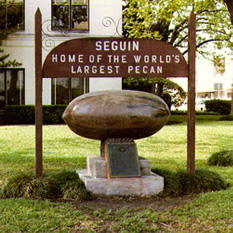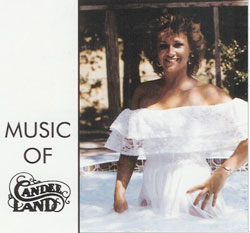|
 Howdy, this is your playwright, Stephen Bittrich! Howdy, this is your playwright, Stephen Bittrich!
Seguin, the town where I grew up (and coincidentally the setting of Home of the Great Pecan), has many cool attractions. Take for example, the Great Pecan. Oh yeah, it's real! "Erected in 1962, the pecan is five feet long and 2 1/2 feet wide, and weighs approximately 1000 pounds. It was dedicated to Cabeza de Vaca, a Spanish explorer who was held captive on the Guadalupe, known then as the 'River of Nuts,' for ten years. He thrived on a diet of local pecans. Seguin began billing itself as 'Home of the World's Largest Pecan,' a title it held for twenty years. " (From RoadsideAmerica.com)
Apparently, in about 1982, the folks of Brunswick, Missouri found more concrete and made a bigger pecan statue, but Seguin's motto "has remained 'Home of the World's Largest Pecan,' regardless of how many postcards are mailed from Brunswick to Seguin's Chamber of Commerce." I like to go visit the Pecan whenever I'm in town. It's not like the Mona Lisa, you can walk right up and touch it.
[New info. Wow, I just found out from one of the cast members that Seguin now has a "Go Nuts - Pecan Fest Heritage Day" which was going on when we were workshopping the first production of the play. Freaky!]
The town is named after Juan Seguin. In the recent Alamo movie it went something like this -- "We need one man to deliver the message to our troupes across enemy lines that we will fight to the end to and never surrender!" Juan Seguin grudgingly accepted that duty, and I believe he was the only soldier at the Alamo who didn't die there. His remains used to be buried in Seguin at the top of a hill which was really treacherous and fun to ride your bike down. The steepest hill in all of Seguin. And there was a cross street at the bottom of it that wasn't that well traveled, but still it was a bit dangerous. You had to peer down the hill and see if any cars were turning onto the street, and if they weren't, off you'd go like a bat out of hell. Poor Juan Seguin didn't get a statue or anything, just a small plaque.
 Candee Land is mentioned in my play as being a popular local Country Western singer at the time of the setting (mid-80's). Candee Land is a real person, and she lived down the street from me on Baker Street for a while. She was always special even when a young child; she had an amazing stage presence. I remember watching her in an elementary school talent show, and all the kids would sing Twinkle Twinkle Little Star or something lame, and then the principal came on and announced, "Next up is Candee Land. She can't take place in the judging part of the Talent Show because she's already a professional, but here she is to perform." And then she came on and blew all the little kids out of the water. I don't know that her CDs are now in print, but try to buy them used on Amazon. If you like to taste country music sometimes, you'll thank me. There are two. "Music of Candee Land" is my favorite of the two. Candee Land is mentioned in my play as being a popular local Country Western singer at the time of the setting (mid-80's). Candee Land is a real person, and she lived down the street from me on Baker Street for a while. She was always special even when a young child; she had an amazing stage presence. I remember watching her in an elementary school talent show, and all the kids would sing Twinkle Twinkle Little Star or something lame, and then the principal came on and announced, "Next up is Candee Land. She can't take place in the judging part of the Talent Show because she's already a professional, but here she is to perform." And then she came on and blew all the little kids out of the water. I don't know that her CDs are now in print, but try to buy them used on Amazon. If you like to taste country music sometimes, you'll thank me. There are two. "Music of Candee Land" is my favorite of the two.
When I was in high school she used to play sometimes with her band, Candee Land and the Goolaks, at The Corral, a dance hall that played about 90% country music and 10% hard rock. It was funny to see guys with roach stompers (cowboy boots), big shiny belt buckles, and cowboy hats rocking out to AC/DC's "Back in Black."
By the way, if you need pecans from Seguin, try Pape's Pecans. If you're in Seguin, and you need great Tex-Mex, go to El Ranchito.
I don't know that I truly appreciated my Texas roots until I left. I was bound for New York City at a pretty early age, but when I got to NYC, I bought my first pair of cowboy boots and started to listen to country music, something I'd not done much while growing up. And I really got into country music when working on this play. I can say now that Seguin provided an idyllic, innocent childhood. I remember riding my bike around the neighborhood with playing cards in the spokes to sound like a motorcycle.
Some of the ideas in the play are based on truth, but most of it really isn't true. Truth is often too unbelievable. But there are certain things which I stole directly from real life, like the formula that the Reverend uses to help people to gage the amount of their tithes. That was from a real sermon I saw once (though on television). MUFON, the Mutual UFO Network had it's World Headquarters in Seguin for about 30 years, but now it's somewhere Greeley, Colorado. (As a weird coincidence, Greeley happens to be the name of one of my main characters. That was not on purpose.) The plan that Tammie Lynn devises to get married really happened in Florida. I read about it once in Jet Magazine when I was working the graveyard shift as a security guard here in NYC (one of my many survival jobs).
We say "Puh kahn" in Seguin. I noticed people in New York City say "Pee kan," and I always had a notion they said it that way thinking that's how we say it in the South. Well, we don't. At least not in Texas.
The Great Pecan, thankfully, has never been stolen, but I do refer to a bull heist in the script. That did happen. I have a newspaper clipping from the Seguin Gazette (unfortunately with no date) which reads:
After I finished the play and read back over it, I wondered if it would ever be put on in my hometown, and I wondered if it would offend anyone. Those who think I'm poking fun at the Great Pecan? Those who think I'm poking fun at the church? Or worst perhaps, those who think I'm making a laughing stock of Texas! I hope I offend none of these. It's a only a silly comedy, written with great affection and dedicated to the place I happily grew up, Home of the Great Pecan.
|
|